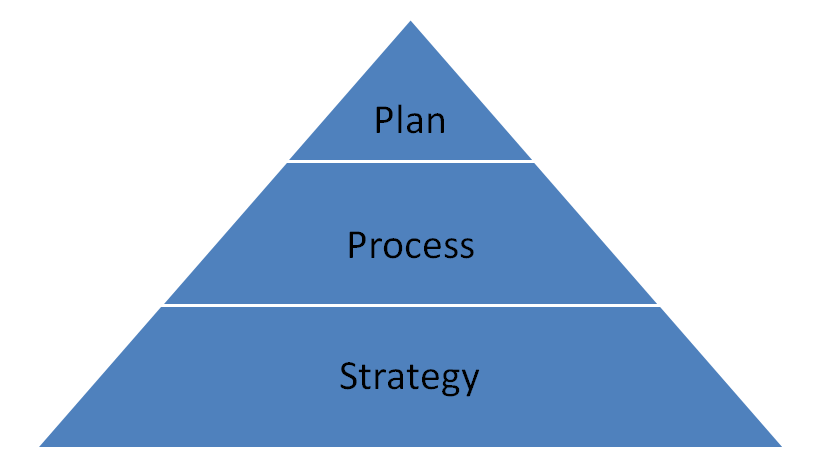There is so much to manage when it comes to your marketing, and with all the surrounding factors it can create a very complex system.
The truth is if you do not have a process driven strategy for your business then you are not reaching you potential.
A marketing methodology is a process driven strategy that account for all the aspects in a linear system. It breaks down all the activities from organisational level, functional level and operational level. So that your marketing is in alignment with your business objectives.
Those companies that do this better will perform better.
In this article, I will take you through the ULTIMATE PROCESS DRIVEN STRATEGY you can apply for managing your marketing.
1. What Is A Process Driven Strategy?
To achieve success in your business you must focus on transforming raw materials into value that meet the customer demands.
We make bunches of strategies to drive the creation of value better than the competition.
In a process-driven strategy, you achieve your marketing objectives in a linear way.
You have the order of the tasks set out in front of you.
Process Driven management is a methodology for constructing non-trivial tasks. Whereby, it is essential to understand the challenges of the business.
This means how the business makes money, what products or services it produces, the interrelationship among vendors, departments, clients, and so on.
2. Why Is Having A Process Driven Strategy Important?
The manner by which business operate are either Process-driven or People-driven.
In a person-driven approach, you must rely on the experience, skills and knowledge of the individual in charge to deliver the strategy.
Nevertheless, there a numerous challenges for this person alone and for the organisation once this person has left.
In a process driven management strategy, you are aware of the next goals you are working towards, and you know exactly the next task before you get there.
Overall, it reduces time to deliver an outcome, the value is greater and efficiency has increased.
3. Strategy > Process > Plan

3.1 Strategy
Before conducting any marketing strategy, we must outline the organisations direction.
We depict the marketing strategy aims directly from the organisational level strategy.
However, more commonly many businesses do not organisational level strategy, which is very common in smaller organisations.
From my consulting experience, I have seen social enterprises and even some corporate businesses that had a quite unclear direction.
Having an ambiguous organisational level strategic direction can have a negative effect on marketing and the business as a whole.
When we create a strategy it is more about the ‘what and the why’
The strategy outlines what channels to use, what imagery resonates best, outlining what direction to take with valid justification of getting towards those desired results.
3.2 Process
However, the strategy does not say much about the ‘HOW’
Dealing with many businesses and start-ups over years, I have developed a lean process that supports the direction of any business.
Specialists are not solving this problem.
In the next section, I will take you through the process.
3.3 Planning
As the financial year ends, corporate Strategists biggest objective is to ensure all the employees have a clear heading for what they are working towards for the new year.
This level of planning trickles down from corporate strategy, to department level and then individual level of employees aggregated in the respected departments.
Moreover, strategists will have produced informed KPI’s, which in turn drive daily objectives which aim to reach the defined goals.
In order to make a clear plan, we need to understand more about the core market strategy.
There are three major elements when creating a marketing plan:
- Organisational level
- Operational level
- Functional level
The organisational level process is establishing long and short-term goals by assessing the the industry and knowing the environment in which you operate.
The operational level is determining how to get to reach the long and short-term goals.
The functional level is implementing through marketing activities that capture the needs of the audience into the delivery. Such as advertising, imagery, flyers, digital and etc.
4. The Ultimate Process Driven Strategy For Managing Your Marketing
The process takes the functional level, operational level, and organisational level duties with a linear process flow.
The model first suggests that there is a starting point towards building and managing your marketing.
This ever so important, as generally you when are thrown into a specialist area, there is always some sort of confusion and you are not quite sure how your job correlates with the other departments
Also, it also good for managers as it can make evident if you have missed something or any gaps in your department for driving success.
4.1 Marketing Methodology
The most common tools that are used by strategists have been formulated into a process model in the above image.
This image makes it easier to visualise how all the tools fit together like puzzles in a jigsaw.
The processes for determining direction have been broken down into three stages: organisational level process, operational level process and functional level process.
The ordering of these tools is detrimental and so in the below image there is a process model.
All these tools fit together like a jigsaw, and the image provides a snapshot of the big picture. As you can see there are many elements to this process, this is because one tool is not good enough on its own for justifying the strategic direction for clarity in the future.
However, dealing with any tools can be confusing and seem daunting, so the above process model visually formulates the recommended time to use these tools for the best outcomes.
5. Organisational Level Process
5.1 Corporate Direction
Corporate direction is searching for an organisation long-term destination providing a more sustainable competitive advantage. This can be looking into new markets and proving different products to increase the demand to their customers.
The first phase of discovering direction is to determine the end destination through a vision statement.
The vision is formed more accurately when focused around the value proposition of the target customer.
These will be your main target audience, with the marketing aim to brand you as the go to products for their pains.
As famously said by trying to please everyone you please no none.
By trying to please one group of people, they will be truly satisfied whereby this can lead onto other effects such as the hype built from that specific segment can build the bandwagon effect.
We then, establish how we plan to get there through our mission statement.
5.2 External analysis
The vision captures the end destination.
We build this by utilising preferences from the customer and knowledge about the industry.
Once our well-informed vision is determined we now need to understand how to get their through our mission.
However, in order to gain clarity of the how, we need to conduct an external environment analysis to work out how our competitors do this, which will inform the strategy broken down into the microanalysis. This also takes into consideration of barriers that our out of the organisation control broken down into the macro environment.
The customers are the most important aspect of any business and so these should be central to the business strategy.
We envision and reassess the Corporate Direction once when we gain new insights from the market research (this is explained in the viral loop from the external environment).
5.3 Micro environment
When trying figure out the organisations direction the tools of most use are Porters five forces as it outlines all the competitors.
Then by using a positioning map, it maps out the entire market using the variable of price vs quality.
In this stage, you can also take it a step further by outlining the competitor’s capabilities using a stakeholder analysis and having a swot for each competitor.
5.4 Macro environment
This includes mapping out a PESTLE to determine all the factors of the environment that cannot be controlled through our business.
These can cause barriers within our mission that block the path and new solution may be needed.
5.5 Internal Analysis
However, we also need to acknowledge that we are able to satisfy these needs from our resources and capabilities, which is highlighted in the internal analysis.
Everything we have learned from external environment gives us a sense of our capabilities compared to our competitors and it is important to outline our current state in a swot analysis.
Furthermore, the values of the organisation need to be outlined in order to determine a mission that is aligned to the organisation.
5.6 Corporate Goals
By which, Goals are then set to ensure the business is on due course.
To meet these goals we need to have knowledge of the gaps in the market.
We do this by a Gap analysis, which is assessing how to reach the goals we set.
5.7 Gap Analysis
The gap analysis looks how businesses operate in a given environment and determine the best way of competing through assessing our strategic options and growth strategies.
When making a basic strategy we need to create concepts of how the environment functions.
These are stored as a business portfolio.
Concept
During my time in marketing and business development, I have found applying a concept massively improves my performance.
First, it provides an initial frame of reference that can be adaptable to new insights.
By starting with a concept will provide you with a better-informed decision-making process. This is because as time goes by will learn and reshape our concepts into actionable strategies, whereby you have created proof of concepts.
Purpose of gap analysis
The purpose for a gap analysis for identifying strategic direction is to identify opportunities in the market by looking at the customers needs against our capabilities. Another reason is to analyse competitors capabilities to try and determine the long and short term heading in the industry.
The purpose of this tool is to compare the value our customers want (captured in the need analysis) again the current delivery
This could include additional features/ services, branding, or even a different approach for delivery that is missing in the current market place but delivers more convenience to the users. To truly understand this for building a long term vision, it has I be compared again a need analysis. This in turn outlines the customers pain, and the reasons behind purchasing the product. This will be the solution our product bring to its users.
However, a gap analysis goes deeper. As it outlines all the stages of the customers journey and measures how well our company delivers for each stage our the customer journey. The gap analysis and need analysis work cohesive. However, This article is focused on the gap analysis.
In short a need analysis outlines the different pains of each customer segment. Whilst the gap analysis outline to most appropriate way of meeting the customer needs. Collecting, and improving methods the competitors currently use, for guidance.
It may be often noted that your organisation can not deliver all the requirements to every customer segment and so a decision will have to be made on which the most valuable customers the vision should be focused towards. A ranking for prioritised customers can be found in the segmentation document.
6. Operational Level Process
For a marketing manager to engage in insightful decision-making, it is essential a marketer make sense of everything from their competitive landscape to their customer behaviours, from every possible context and perceived angles.
This is so that we deliver a superior customer experience and thus a competitive advantage.
6.1 Marketing Direction
Once the organisational direction has been set, it is time to discover the marketing direction.
The purpose for setting a marketing direction is ensuring the marketing team are aligned to the organisational direction, as well as making sense of selling the products to customers.
It is important that we ensure all departments are aligned, and on track towards the corporate vision else it will risk rupture.
Rupture occurs when each department have their own visions for the business. The business then begins to split in different directions and is pulled apart from the inside. This a common cause for failure.
Using the business goals, vision and mission, as well as understanding the internal and external we form a situational analysis.
This carefully highlights how we can utilise our resources and capabilities when competing against our close rivals.
Through this we set our marketing aims and objectives and have a clear direction for the operational level.
Remembering: the business should be aligned whenever marketing aims are established.
6.2 Environment Research
The leading firms are combining advanced qualitative insight methodologies (such as ethnography and cognitive research) with an entire ecosystem of quantitative data-driven observations about their customers to achieve ever-deeper customer understanding.
This gets the marketers ahead in the game and allows marketers to think differently and more effectively when it comes to conducting strategies.
6.3 Marketing Strategy
Through the market research we establish who the most valued customers are, and what these people require.
We do this by the basic segmentation, targeting and positioning strategies.
There is many ways to determine an organisations most valued customers. The most accurate is looking at sales records and compiling them against the different types of customer segments.
The attributes that are of most significance are;
- Volume of customers in each segment
- Total spending on average each customer make in that segment
- Return rate of items those customer make
If your organisation is not collecting this type of information, it is essential to start collecting demographic, behavioural and psychological data from your customers.
6.4 Branding
Through everything we have learned we need to establish ways to communicate to our customers.
We capture this in our branding guidelines and covers everything from brand image, brand personality and brand identity.
6.5 Product Strategy
The next step to determine the target customers is to give each customer segment a quality score by the following calculation and then forming a need analysis.
A wants and need analysis is learning about our customers their journey and forming it into a persona.
Moreover, this includes what our customer pains are, what are their desires are.
By compiling both the wants and needs of the target customer into a persona you can more accurately form value propositions and build brand awareness strategies that really work.
6.6 Market Research
This report has all the desired usage of the products and services by the customers for each segment.
We collect this information by:
- Interviewing small sample of each target segment
- Questionnaires
- Google analytics and website
- Customers services
- Product feedback
All the requests and desires should be collected into a document to get a sense for the future delivery.
6.7 Target Customer
To successfully targeting customer we need to establish some measures to determine which the best group of customers for our business.
The measure we are interested in is;
- Volume got customers
- Average Purchase spend (APS) per person
- Average Return rate (ARR)
We can then formulate a quality score. The quality score is:
Volume + aps – ARR
Once you do this you will know all your customers and the value they deliver to your business.
Furthermore, by having a quality score it is easier to assess the priority of each customer segment.
Overall, this makes it easier to know at first glance whom you should be aiming your vision too.
6.8 Communication
Once we have our strategy outlined, we can then begin to assess how we want to brand and communicate our products.
7. Functional level
The functional level is the process of implementing the strategies of the organisational level process and operational level process.
7.1 The Job Roles Of Marketing Functional Department
What does the job of a marketer entail?
Before, I take you through the process driven marketing strategy it is important to know what the disciplines in this industry are.
This is important because you need to allocate your resources and fill-in in the gaps of your resources for your optimal performance.
However, before you can do this you need to understand what they are.
The disciplines of marketing:
- Advertising and Promotion
- Market research
- Product Development
- International
- Personal Relations
- Branding
- Digital Marketing
7.2 Managing The Functional Department
To be able to manage the functional level in your marketing operation you need to be able to break everything down in smaller pieces and understand what performance you are getting out from this.
In order to do this we need to answer three questions.
- Which activities are we doing to get leads?
- How do people travel before they make a purchase?
- What mechanism speed up the purchasing?
- What is our conversion rate via channels
We use the marketing machine to manage the functional level process as it outlines the leads, the purchasing cycle and the nurturing system which answers all the above questions.
7.3 Marketing Machine Model
The above image is a depiction of typical marketing departs and how it should be managed. However, this will vary slightly for your organisation
Lead management – In the orange boxes we have outlines all the leads our business uses to gain clients into our business.
Managing the customer purchasing cycle – In the yellow boxes we have outlined all the actions customer go through before a typical purchase.
The nurturing system -In the blue and purple boxes we have outlined all the activities we do to try to encourage a purchase and repurchase.
7.4 Review and control
Managing the channels – In order to manage the channels we need to know conversion rates, cost of conversion and ROI.
Finance and budgeting – we need to be able to manage the channels all marketing activities all within a strict budget.
So, careful financial planning must be considered.
Conclusion
The process is good as it outlines to marketers how organisational strategies are formed, and so marketers have a sense of the big picture.
Marketers will end up aligning their aims towards the organisational strategy and so when there is gaps in their knowledge they need to know where to find that info, or if a small organisation, what tool to use to extract that knowledge.







